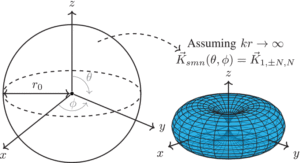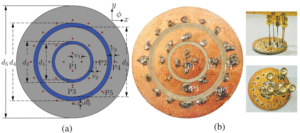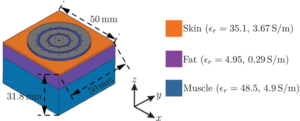MIMO antennas have received much attention in modern wireless communication. The technology can transmit or receive data using multi-paths, increasing range and output performance. MIMO offers numerous advantages, including increased data rates, improved signal quality, better coverage, and enhanced spectral efficiency.
In an article in IEEE Transactions on Antennas and Propagation, researchers propose a compact 3-D beam-steering MIMO antenna for on-body Internet-of-Things (IoT) applications.
Using the MIMO antenna operating at 5.75 GHz improves signal strength and reduces battery use, making it suitable for emerging on-body IoT devices.
The researchers outline their process in creating the improved MIMO device, including discussions regarding the planar antenna, beam-steering concept, specific absorption rate (SAR) below the established limits, and 3-D beam-steering characteristics while operating in an on-body setup.
Antenna Design
After charting the equations used in the study, the researchers explain how the theory of spherical modes describes the antenna beam-steering in the xy plane, and the beam-scanning is extended to cover the xz and yz planes through the excitation of broadside modes.

Visualization of the smallest sphere that fully encloses an antenna.
To implement the proposed principle in on-body devices, a centrally located patch and concentric annular rings were used to design a planar structure. The proposed antenna includes 28 shorting pins, all of which have a diameter of 0.5 mm. During the prototype stage, the pins will consist of copper wires of 0.5 mm in diameter. To highlight the antenna's robustness concerning the shorting pin dimensions, the researchers conducted parametric studies, where the tolerance value was doubled to ±0.01 mm.

Proposed antenna (a) top view, and (b) manufactured antenna, the left image shows the antenna top view, while the right images show the antenna bottom view to highlight the feeding system.
Performance
A multilayer phantom was used to investigate the antenna performance for on-body applications. In the simulation, the phantom comprises three layers: skin, fat, and muscle. The researchers found that, unlike previous works, this proposed design is capable of continuous beam-steering over the entire azimuthal plane with good scanning in the elevation plane. This represents a significant breakthrough in enabling advanced wireless applications in on-body IoT devices.

Proposed on-body setup using a three-layer phantom.
The proposed solution will enable advanced wireless applications like localization and physical layer security in emerging size-constrained on-body IoT devices. The 3-D beam-steering characteristics are achieved without externally controlled switches, supporting the generation of multiple simultaneous patterns at the same frequency. Overall, the design is compact, low-profile, planar, suitable for packaging with emerging on-body IoT devices, and compatible with many advanced wireless applications.
Interested in learning more about the Internet of Things? IEEE offers continuing education with the IEEE Guide to the Internet of Things course program to smartly implement digital tools into your organization.
Interested in acquiring full-text access to this collection for your entire organization? Request a free demo and trial subscription for your organization.





